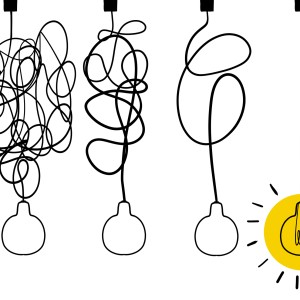Education experienced unimaginable disruption and upheaval due to COVID-19.
Educators and students alike felt isolated and overwhelmed as they faced increased class sizes and the ambiguity of asynchronous learning. Relationships and honor codes were tested. The most foundational issue of all was who had basic internet access, and who had the socioeconomic means for software and hardware. The pandemic and subsequent shift in learning exposed chronic systemic disparities and inequities and transformed other chronic issues like academic integrity into acute pain points.
But educators also adopted new technologies and new pedagogical approaches to mitigate these challenges and support learning. In short, ever-resilient educators innovated.
Disruption often opens up opportunities for permanent and positive change--what will we as educators, going forward, adopt as priorities and what will we retain from what we learned during the online learning experiment of 2020?
Terry Heick, in a prescient 2019 teachthought piece entitled A Disruption Model: How Innovation in Education Causes Change, outlines the learning innovation cycle in four steps:
- Emergence of Disruption
- Impact
- Recalibration
- Evolution
Let’s take a look at what we’ve learned and the opportunities for permanent, positive change in education within the above framework of learning innovation.
1. Emergence of Disruption
The pandemic caused educational institutions to pivot abruptly to remote learning, away from traditional, in-person learning and longstanding curricula. In effect, this was forced change.
Rick Staisloff, in The Chronicle of Higher Education’s report “The Post-Pandemic College,” says, “What has changed since Covid-19 is the urgency that higher education must now bring to addressing these longstanding challenges. John Kotter, in a 1995 Harvard Business Review article, ‘Leading Change,’ cites a lack of urgency as the top reason that transformation efforts fail. Covid-19, for all its unwelcome and tragic effects, may provide the necessary push to a more sustainable future” (p. 38).
The COVID-19 disruption brought an urgency to address both chronic and acute student learning issues.
2. Impact
The impact of emergency online learning environments was immense and chaotic, highlighting inequities that ranged from access to the internet to socioeconomic struggles. Some of these inequities were exacerbated by online learning environments but most inequalities existed long beforehand and were brought into sharp relief within the context of remote learning.
Anthony Abraham Jack, author of The Privileged Poor states, “Covid-19 is an unerring mirror reflecting back upon America’s true self. It reveals not new truths but rather old ones: that our society is depressingly unequal, deeply divided...To think about the future of higher education, to the days when Covid-19 is in our rearview mirrors, we must first contend with these entrenched inequities that we struggled to deal with when times seemed good. Covid-19 exacerbated social ills; it did not create them” (The Post-Pandemic College, 2020, p. 31).
The pandemic was like a quality assurance stress test--how stable was the infrastructure, how reliable was the curriculum, how effective were assessments, and what were the explicit responsibilities of educators and students? Institutions left and right were struck with a hammer repeatedly. Were all learning styles addressed? Did all students have access to online learning environments?
Teachers--even tenured staff--were laid off or furloughed due to institutional financial distress. Cuts in personnel are the leading cost on most campuses; thus, early retirement offers became more urgent.
Teaching burdens increased as class sizes increased. How much synchronous learning should take place? Is it the teacher’s responsibility to be present at all stages of learning? What is a teacher’s responsibility with regard to student emotional wellbeing, and what were appropriate strategies to reach and include students?
Two crucial questions lead to 2020’s impact on academic integrity issues: were tests accurately measuring student learning? And did students feel supported enough to not resort to short-cut solutions? Some colleges and universities with an established culture of academic integrity fared well. But even institutions with established honor codes faltered; West Point, a prominent U.S. Military Academy, found itself embroiled in a cheating scandal in December, with the administration directly blaming remote learning. According to USA Today, “Army Col. Mark Weathers, West Point's Chief of Staff, said in an interview that he was ‘disappointed’ in the cadets for cheating, but he did not consider the incident a serious breach of the code. It would not have occurred if the cadets had taken the exam on campus.”
2020’s disruption made chronic issues urgent.
3. Recalibration
Many nimble educators investigated new learning models, adopted new assessment design, and made adjustments throughout emergency remote learning.
Flower Darby states, “We experienced a calamitous, one-two punch in the spring of 2020 that rocked higher education like never before. Because of the coronavirus, we pivoted online in just a week or two in March. The lasting impact of this frenzied shift? Teaching without technology is no longer a thing. If we’re teaching, we’re using tech. That’s not going to change” (The Post-Pandemic College, 2020, p. 14).
Online learning environments necessitated increased feedback loops and frequent, low-stakes assessments to mitigate the lack of in-person student-teacher interaction. This is a best practice regardless of learning platform, one facilitated by educational technology (Feedback Studio, Gradescope). Assessment design, too, evolved in 2020. Remote learning required that assessments be more accurate than ever--and made for thoughtful data-driven assessment design based on item analysis.
Lectures shifted as well, with some traditional lecture formats being divided into shorter chunks. "There's this assumption that the best way people learn is by sitting quietly in a class for 80 minutes at a time and then regurgitating facts every four weeks on exams," according to J. Erik Jonsson Smith, a professor at CMU. "In fact, that's not how most people learn. I hope that we can take these disruptions — and this need to embrace technology in new ways — as an opportunity to open up education to people who learn differently." In the shift to online learning environments, educators had to “reimagine what class participation and interaction looks like,” and thus were open to change and greater inclusion for different learning styles.
Thomas J. Tobin, the Director of Learning Design, Development and Innovation at the University of Wisconsin at Madison, echoes the above point. “What we do hasn’t actually changed all that much. How we do it has changed and shifted radically” (The Washington Post, 2020).
So what methodology will change?
4. Evolution
“The pandemic is speeding up changes in a tremendous way,” says Bert van der Zwaan, former rector of Utrecht University in the Netherlands (Nature, 2020).
Educators have adopted a growth mindset in the wake of COVID-19. Simone Buitendijk, Vice-Chancellor of the University of Leeds states, “I want to think about how the University of Leeds can come out of the Covid crisis not just intact but actually better than we went in, and that means prioritising the things that I would have been doing anyway but are even more important now because of the Covid crisis” (Times Higher Education, 2020).
As schools move forward to 2021 in the tail end of a pandemic and beyond, they will also adopt some of the new experiences gained. Educational technology will take a greater role in the learning process. Assessment software that upholds best pedagogical practices, for instance, has a long term place in the realm of education and student learning.
According to this September 2020 Vox article, “The idea that digital technology could be used to improve higher education has been a major point of debate for at least a decade — and it’s barely gone anywhere. The pandemic is painful on many levels, but in this case, it’s forcing a huge portion of faculty members in the US to make the large upfront costs of mastering the technology to create something that will have enduring value for years to come.”
Evidence-based, data-driven decisions, central to measuring efficacy in remote learning and more easily accessible via technology, will be a part of the teaching landscape to come. “A more sustainable future will need to include a recognition of student learning versus seat time--measuring what students have learned, not just the time and effort spent learning,” states Rick Staisloff, who adds, “Successful institutions over the coming decade will put structures in place that support the move to a data-informed culture” (The Post Pandemic College, pp. 42-44).
Data-driven decisions and item analysis helped navigate the acute pains of remote learning but will also facilitate change with more chronic pain points by providing indisputable evidence and measurements. The end goal is more active and inclusive education. Lindy Elkins-Tanton states, “In my fantasy world, I’d hope that as we come back in person, education can move in directions where students have engagement and inquiry and ability to take some action in their education instead of just being passive. I think this is especially critical in terms of equity. This goes right along with Black Lives Matter and every push for equity and diversity that you can imagine. You have kids who come from backgrounds where they weren’t given power, where they don’t have resources. And you put them in classrooms where they’re taught to sit down and be quiet — you’re taking away their agency” (The Verge, 2020).
The need for permanent changes in higher education is undeniable. And while the ongoing disruption that began in 2020 has upended decades of traditional curricula and teaching materials, there is now an opportunity to make education more equitable, accessible, and accompanied by data that supports student learning and teaching efficacy.







